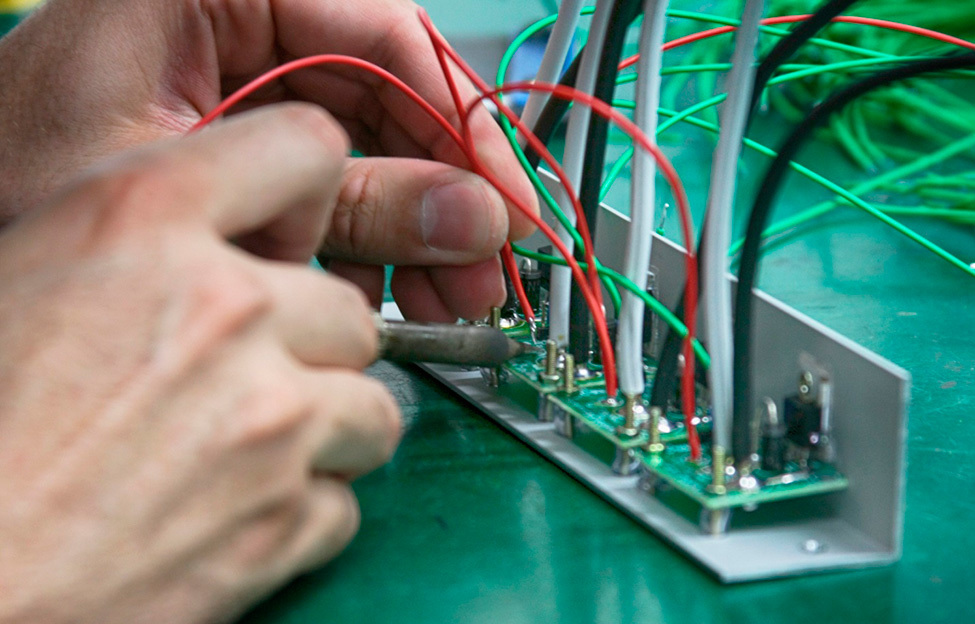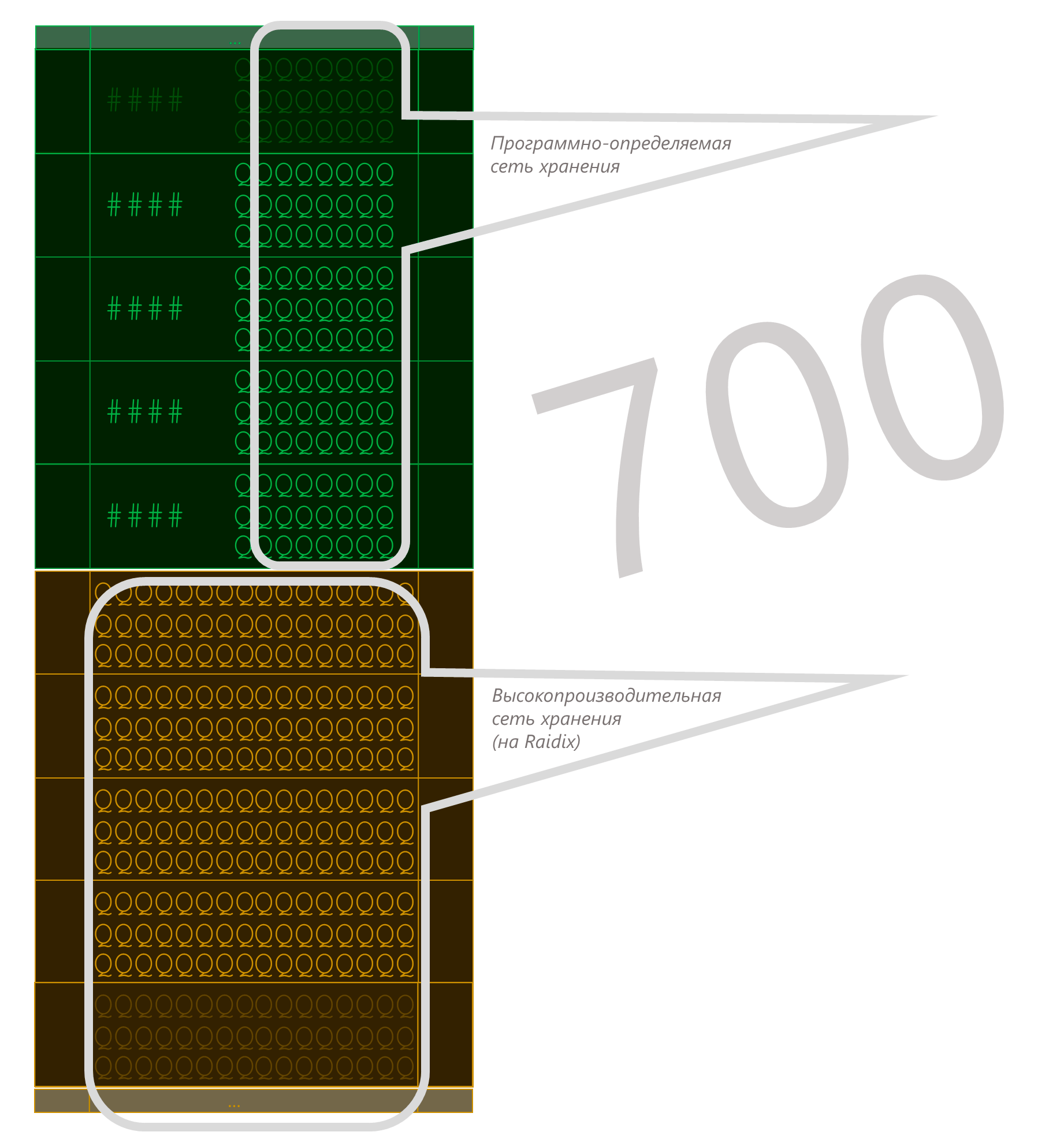Entirely Russian, convergent and ... hyperconvergent. Why we made the platform "SCALA-R"

Talking about testing our product - the first Russian convergent platform "SKALA-R" for compatibility with ERP-systems or Russian EDMS , we did not dwell in detail on the origins of the project. In this post, we decided to put together the whole “kitchen”: to talk about how the IBS Interlab team went from idea to realization “in hardware”. We will also show in more detail what our complex is made of and “insert our 5 kopecks” into a lively discussion about the struggle between convergent and hyperconvergent solutions.
World of integrated systems
')
Since the beginning of the 2010s, there has been a massive shift in the minds of corporate IT customers, and instead of buying hardware and software for each individual information system, many have begun to think strategically: to build a universal infrastructure so that its resources can be distributed to various IT systems as needed.
“Growing up” of virtualization technologies and the spread of cloud ideology played their role. And even at the dawn of the "clouds" meant only public , over time, a private deployment model was formulated and implemented. The “ clouds in the box ” were not long in coming - integrated systems , pre-configured conglomerates of servers and network equipment, the release of which was mastered by several leading IT manufacturers.
Integrated systems have significantly reduced the cost of creating a private cloud, and, most importantly, dramatically increase the predictability of the success of this event, simultaneously reducing the time required for deployment and migration from previous decisions. IBS , of course, as a major and advanced system integrator, was among the first to introduce such complexes. For several years we have accumulated substantial experience, which allowed us to master these solutions quite deeply and extensively. It happened that in the process of gaining experience, they imperceptibly attacked the rake, but all the problems were answered, and sometimes one had only to be surprised at the elegance of engineering and software solutions, and often of the orderliness and perseverance of Western developers.
If not us, then who?
Hardware and software solutions of such giants as VMware, Cisco, EMC, NetApp, Oracle are, of course, wonderful, shelled on tens of thousands of customers all over the world, but domestic solutions have grown and matured in almost every cloud area: virtualization Network storage, orchestration, management and monitoring, and we are able to assemble equipment. “ Is it really impossible to make the same complex entirely on our Russian decisions? "- our customers asked for which sanction risks are not an empty sound. “ Is it really impossible to make these complexes more productive and cheaper - using container virtualization and elegant software-defined storage networks? ”- asked those who followed the development of the IT market and did not want to pay extra money just for the well-known logo on the cabinet.
So, having heard these questions and “standing on the shoulders of giants” - having worked a lot and seriously with almost all integrated systems present on the global market, we set about trying to create a modern integrated system from Russian “building blocks”. Why not - this is the task of integratorskogo class , to bring together equipment and software in such a way, to choose the optimal configuration, so that everything works harmoniously and would be suitable for a sufficiently wide range of customers with a fairly wide range of tasks, to bring together and make friends different suppliers in order to deliver finished products quickly and with minimal costs “on the mountain”, which could be promptly delivered to our customers.

The basic scheme of "SKALA-R" (and any other convergent PAK)
Taxonomy: platform, convergent, hyperconvergent
The natural question is - what place in the world of integrated systems can such a decision take? Here, perhaps, it is worthwhile to deal with the taxonomy of this very world of integrated systems. IDC, following the logic of cloud service models, divides the integrated systems market into platform systems and infrastructure.
Platform systems - providing platform software resources, such as DBMS, application servers, development environments, this class includes Teradata data processing and analysis complexes, manufactured since the 1980s, Oracle Exa complexes (Exadata, Exalogic, Exalytics) ), complexes with a ready-made set of Hadoop ecosystem solutions appeared not so long ago. All these products are extremely interesting, many of them can be spoken of as masterpieces of engineering, but these are usually highly specialized solutions, in each case for a rather limited class of tasks, and, as you already guessed, today it is not them (but then Be sure to return to this topic!)
The second segment - infrastructure complexes - “infrastructure cloud out of the box”, allows you to build an infrastructure on which to quickly and with sufficient simplicity and flexibility to deploy and flexibly manage all the IT needs of a modern organization — mail servers, infrastructure remote workstations, application information systems, file repositories. Among the infrastructure complexes, there are two more subsegments: convergent and hyperconvergent . The building blocks of the first are divided by purpose: some of them are computing nodes, others are storage nodes, such are FlexPod and VBlock. In hyperconvergent, each node combines the role of a storage node and a computing node, the most eminent representatives of this Nutanix and SimpliVity subsegment.
Hyper-converged systems appeared a little later, and their market share is still incomparably small, so, according to IDC estimates for 2014, the global supply of infrastructure complexes as a whole approached $ 6 billion, while according to the same agency, hyper-convergent systems sold $ 373 million. However, this share is growing: hyperconvergent grows faster than others in the market, for the last calendar year - more than two and a half times! Perhaps because of this, analysts from Gartner view the segment of hyperconvergging systems as a completely independent part of the market for integrated systems, without uniting, as in IDC, convergent and hyperconvergent into one segment.
And although many of the hyperconvergent vendors rightly say about almost unlimited scalability, but it so happens that their main consumer is organizations that fall into the category of small and medium businesses. There may be many explanations for this, perhaps the presence of a dedicated high-performance storage network “big customers” is considered critical for loaded transactional applications, the fact that the main hypercomputer systems vendors are relatively small and start-up companies also plays a role (while large organizations prefer to work with IT grandees), perhaps, for large customers, the maneuver is important in terms of the ratio of computing power and storage capacity, with which the hyperconvergent has resolved it's harder.
Hyper-convergence and convergence in one box
So, figuring out the alignment of positions and trying to understand which complex we should offer to Russian customers, we concluded that there is no point in categorically choosing only one approach: once in hyperconvergent solutions, the traditional SAN often lacks the traditional defined storage network and ease of scaling, why not connect all the possibilities? It is said - done, united in a consortium with several Russian manufacturers, in a short time such a solution was designed by us, and received the modest name "SKALA-R".
Servers, switches, SAN nodes for the complexes are assembled by the Russian company DEPO Computers , and they themselves have designed and debugged all the hardware components.
Parallels has developed a virtualization and management platform, as well as a software-defined storage system for the complexes. The uniqueness of their solution is that it allows you to simultaneously launch both classic hypervisor virtual machines and containers, and manage all this baggage from a single control panel. Software-defined storage Virtuozzo Storage (still better known by the old name - Parallels PStorage) allows you to turn each server into a single hyper-convergent storage network node. The “shelves” of the classic storage network are charged with software from the St. Petersburg company Raidix. Monitoring of the complex is provided by software solutions of the Russian developers Naumen and IHD Monitoring.
From junior to senior: three hundred, five hundred, seven hundred
Our youngest complex, the SCALA-R 300 series , can be supplied as a fully hyperconvergent, without a high-performance storage network. This option is aimed specifically at customers belonging to the so-called “ small and midsize business ” (this is, if on a global scale, from the point of view of domestic realities, it is correct to call them medium-sized organizations). The cost of the complex starts from 7 million rubles, it is equipped with servers with two processor sockets in a classic horizontal design with a height of two assembly units each (the nodes of Nutanix and SimpliVity are made in the same design). The minimum configuration is 4 server nodes, and there are no limitations on the number of nodes above, so the “junior” of this series can be considered conditional, connected with the ability to start small.

The SKALA-R 500 series is completed with computing nodes with a height of one assembly unit, if the servers for the 300th series have 24 places for installing disks, then in the construct for the five hundredths there are only 8. The price for the most modest configuration is with four computing nodes and four SAN-shelves - starts with 7 million rubles. Typical tasks for the “younger series” are in some sense universal, “IT services of a wide profile”: VDI , corporate postal services, group work platforms, IT service systems, while on the SCALA-P series 500 and more can systems with a noticeable transactional and analytical burden should also be installed.

SKALA-R Series 700 - complexes of powerful four-processor nodes in housings with a height of two assembly units. With this series, an additional hardware and software module is usually supplied - the Acronis backup system. Such machines can be trusted with business-critical loads, for example, in conditions where a database server requires several dozen processor cores “in the monolith,” on one node.

Thus, customers have the opportunity to use the classic SAN demanded in many specific cases, while naturally having the same controls on the entire structure, while preserving the hyper-convergent core and all the beneficial properties of this young class of solutions.
Total
Still, the main thing in this complex for Russians is its domestic origin. Critics will not hesitate to pay attention to the fact that iron components are produced in Southeast Asia, but now there are no other alternatives. It is much more important that all the hardware stuffing is designed, ordered and assembled in Russia, and the most important thing - the software heart of the complex - is entirely created, developed, supported in Russia. And in this most fundamental matter, there are no compromises and, as we believe, there should not be: with the virtualization and management platforms of non-Russian origin, even if they are built on the basis of free software, we cannot build the Russian complex, and those organizations that have encountered with sanctions firsthand, it is not even necessary to hint at this. As of the end of this year, there are no other such fully Russian integrated complexes, and in this sense, SCALA-R is unique.
Although, of course, in the global world of integrated systems, SCALA-R is a new word. Combining hyperconvergent and convergent infrastructure, container and hypervisor virtualization - the complex creates new meanings in this fast-growing market, and we are sure that we are contributing not only to Russian business, but also to the global mind :-)
Source: https://habr.com/ru/post/273959/
All Articles